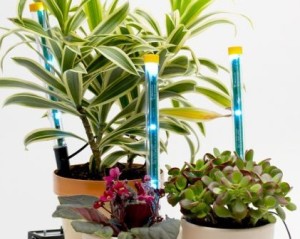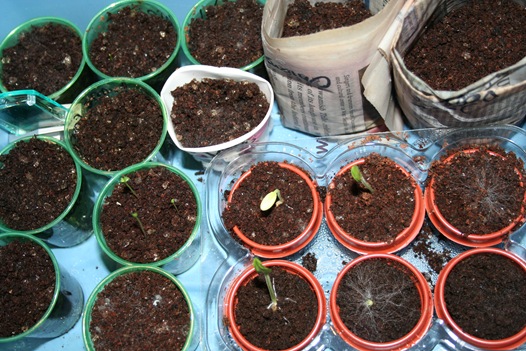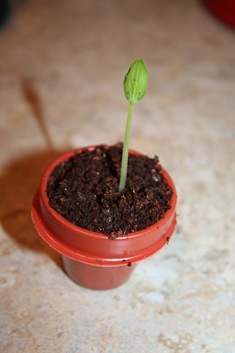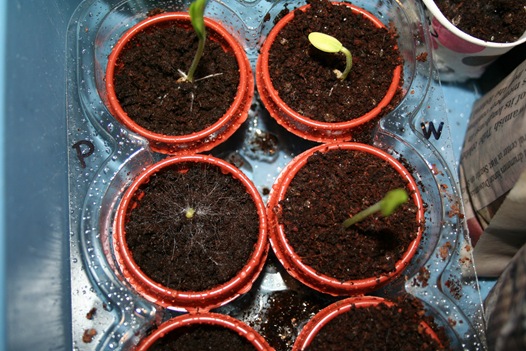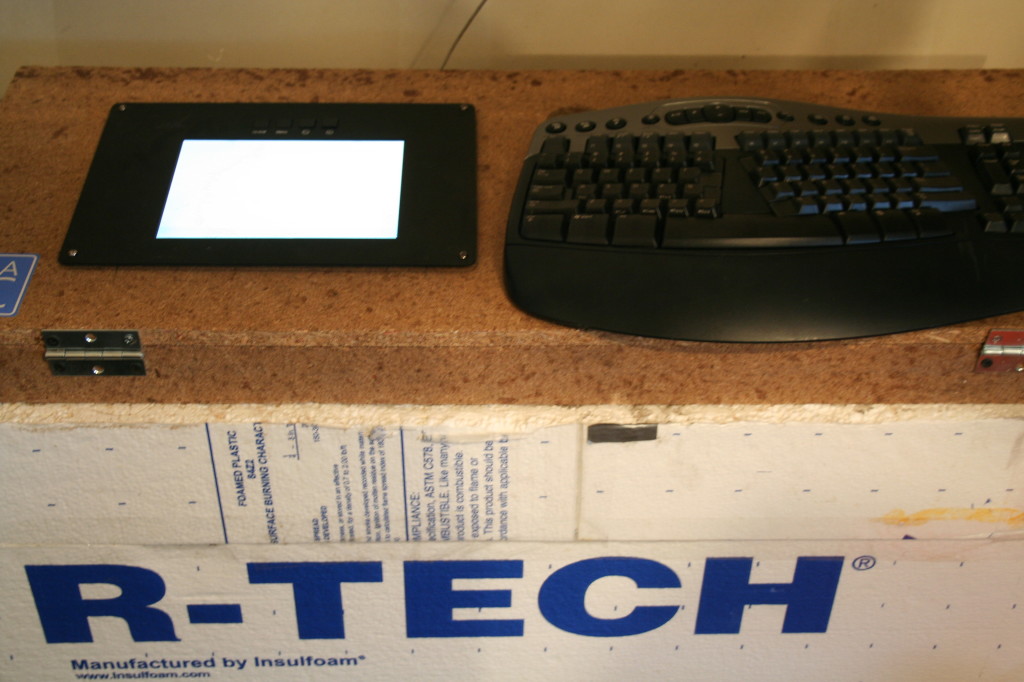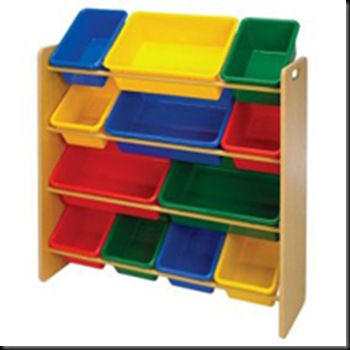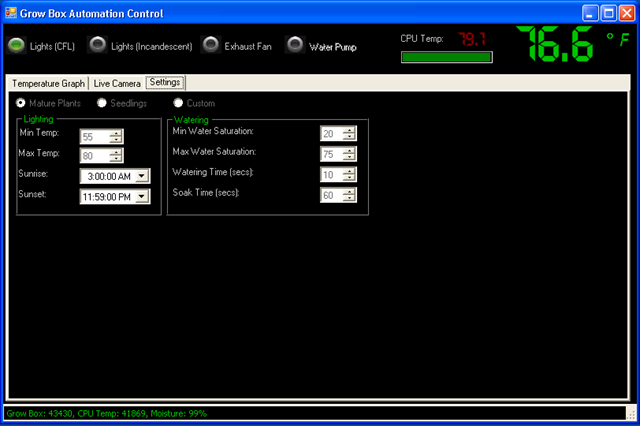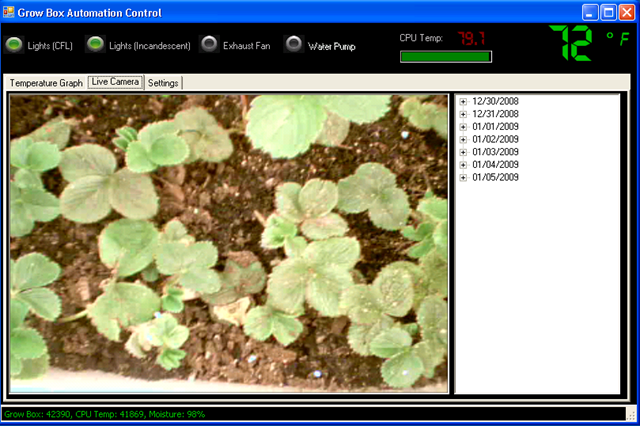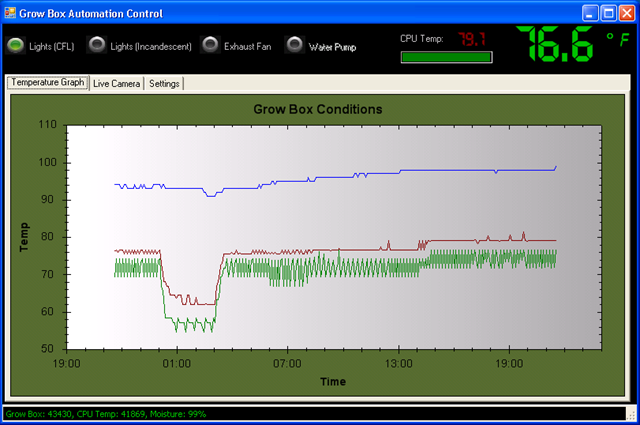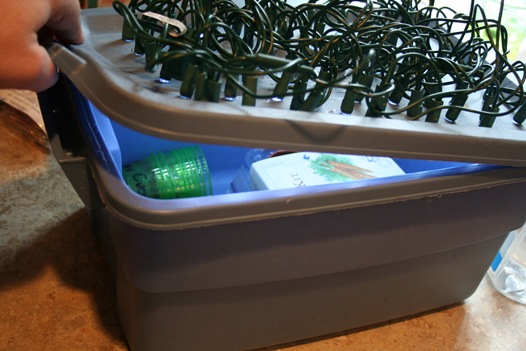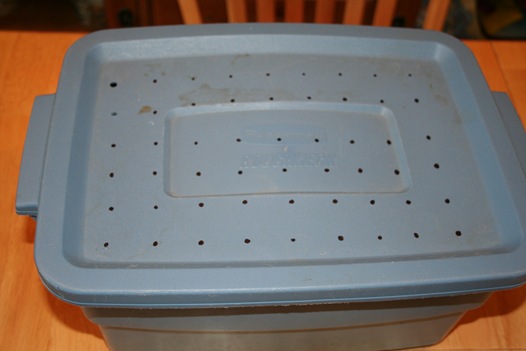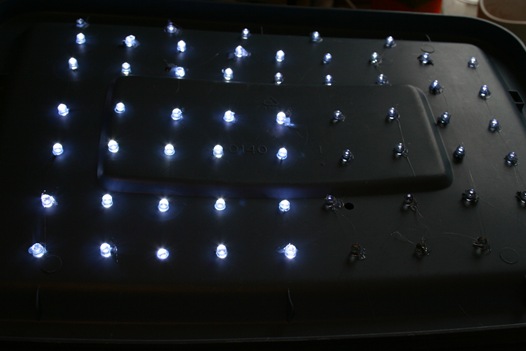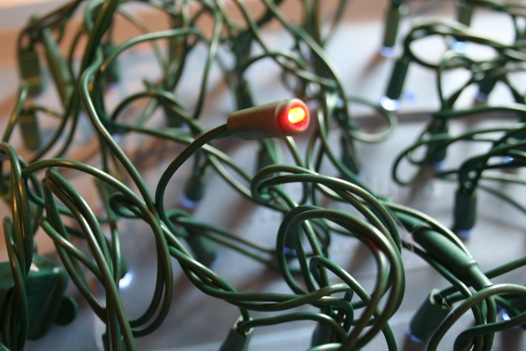LED Plant Grow Spikes
15.3 years ago electronics, LEDs
Not sure how effective these would be with so few LEDs but they do look pretty cool. In their defense they do label these as supplemental lights. If you want one, unfortunately you have to make it yourself with full DIY instructions below.
via Gizmodo via PopSci via Lifehacker
Tags: grow lights, led, outdoor plants
Why you should check on your grow box (especially if it is computerized)
15.3 years ago blueberry, computer, cucumbers, indoor growbox, strawberries
My day job is in software development, so of course it came to mind that software/hardware can fail while I was making my computerized grow box. During its inception, I would check on it daily physically or remotely to make sure all was well. After a couple weeks of this it was so stable that I started to not check quite as often. Though in my mind there was never any question of if it would crash, it was when. Well that answer came tonight when I decided to check on my strawberries, cucumbers, and blueberry plant (trying to propagate a blueberry plant damaged in recent snow storm)
I noticed the lights were out and turned on the LCD display to see “Unable to find operating system.” Before anyone screams “you should have used Linux”, the problem was completely hardware related caused by a failed hard drive (not even the one with the operating system). Unfortunately this was the drive that had the SQL database, so hopefully I will be able to savage some of the data. Once I got the machine to boot up I saw the temperature was down to 38 degrees (poor little cucumber plants) but fortunately in the time it took to write this post it warmed up to 47.3F 57.7F, so hopefully the cucumbers will feel better in the morning.
Tonight I am adding one more item to my software to do list, a Vista Gadget to monitor the health of the grow box to ensure it is up and running. This was also a good time to ask the mental question, “When was the last time I backed up my code?” Code now backed up and am wondering why I am breaking my cardinal rule of always having source control even with a single developer.
Tags: cheap, grow lights, growbox, led, outdoor plants, strawberry plants, vegetables
Why should you have a grow box?
15.3 years ago indoor growbox, indoor seed starting, LEDs, seeds
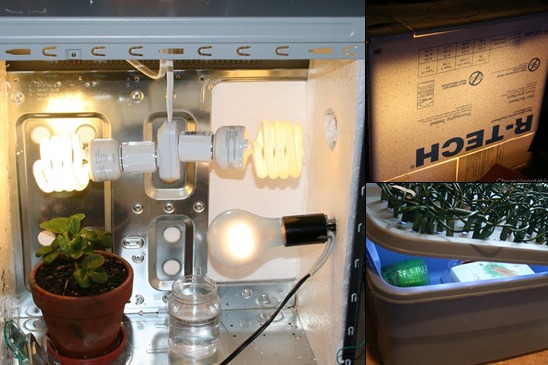
Other than the “Do you really just grow ‘strawberries’ in your grow box?” question. The most common question I have gotten is why exactly do I have a grow box. Hopefully I will be able to answer this question below, as for the first question the answer is yes (without the fingerquotes)
Necessity: I am cheap and don’t want to buy all my plants from local nursery or garden center, but do not have a good location inside my house to grow seedlings with a normal table/shelf light setup. I definitely do not have the space to setup a greenhouse in the backyard. This unfortunately forces me to do my growing in my cold windowless garage. Using a grow box allows me to maintain a safe temperature for my plants no matter what the conditions are outside.
Control: I have nearly complete control of the conditions inside the grow box. I can provide my plants with the perfect temperature, humidity, lights (intensity and wavelength as well as day/night simulation) and even can simulate a slight breeze using a small fan if desired. This gives me many advantages which I would not have even if I could grow indoors. One example of this is growing peppers, which can be fairly difficult in our climate but with some modifications settings in the grow box can create the perfect conditions for it.
Saving Money: Given my options such as the $20 PC Grow Box and my $6 Christmas Light LED Grow Box the cost of entry is pretty low. You do have the expense of lighting the thing but given the 48 watts required for the PC Grow Box and 10 watts of the Christmas Light LED Grow Box even those maintenance costs are reasonable.
Portability: All three of my grow boxes (PC Grow Box, LED Grow Box, Computerized Grow Box) all have a single plug that goes into the outlet and can literally be picked up and moved to another location if needed (try doing that with your greenhouse)
Scalability: Need more space in your grow box? As little as $6 can get you a new one, or $10 worth of lumber can double the size of your existing one (assuming your old lighting can support the space) You are limited to what your creativity can imagine.
Fun: Call me crazy, but I like the idea of tricking my strawberries that it is a nice spring day and get them to start blooming and producing fruit. If all goes well I can move the plants outside during the real spring and get even more harvest while freeing up some space for more plants.
Tags: cheap, garden seeds, grow lights, growbox, led, outdoor plants, pepper plants, strawberry plants, vegetables
Christmas light LED grow box – Update #1
15.4 years ago indoor growbox, indoor seed starting, LEDs, wondersoil
I have been pretty impressed with the results of the Christmas lights LED grow box so far. I did have some preconceptions that I may need to double the lights or upgrade the LEDs, but so far the plants look healthy without white leggy stems, though still need to wait until the true leaves come in. As you can see in the picture above I have quite a selection of pots reused from previous years. The one exception are the newspaper pots which I discovered last year and am definitely a fan of. You can also see from the gross white stuff that my grow box probably could use a fan or at least prop a corner open.
Here is a picture of one of the cucumber plants up close.
My experiment is being conducted in the LED grow box so for its update, looks like is in the lead but hard to say with just germination occurring.
UPDATES:
Christmas light LED grow box – Update #2
Tags: cheap, grow lights, growbox, led, outdoor plants, vegetables
Computer controlled grow box – Part 1
15.4 years ago cheap, computer, electronics, indoor growbox, PC thermometer
The Idea and Design
My PC Grow box was very effective though it did have some shortcomings along with my desire for tinkering caused me to create a new version code named “Project Everbearing” after the test subjects for the project, several Everbearing strawberry plants I propagated from my garden last Summer/Fall. The specific shortcomings I wanted to overcome were temperature control and limited size. My grow box has to live in my garage so on cold nights the temperatures can fall low enough to kill my summer seedlings (tomatoes/cucumbers) Size is an easy fix just make it bigger though it is more difficult to keep a larger grow box warm and still well lit.�
My solution to both of these problems was the addition of a computer to the system. First computers generate heat, using this along with computer controlled fans and incandescent lights (heater) allow me to regulate the heat to my desired levels. This is the point a normal person may have just stopped, but I am far from normal and decided a few more features, which I will explain more below.
The Structure and Insulation
First comes the structure, upon inheriting a set of shelves from my sister, we ran out of room for some of our existing storage shelves (see above), though we used the buckets to store loose toys on our new shelves we had the structure of the old one sitting in the garage for some time. After many passes by in the garage not knowing what do do with this shell, it finally came to me that this would be perfect for my new grow box, (Reduce/Reuse/Recycle) in action. The only customization required was the removal of a couple of the wooden dowels and I was ready to add some hardware. Of course you could do the same thing with an old bookshelf, cabinet or just with construct your own frame with a 12”X1”X8’ foot board cut in two along with two 1”X1”X8’ pieces of lumber cut into two. Screw one 1”X1” in each corner and should should have a pretty solid frame. For the top I used pegboard mainly because I bought a 4’ by 8’ sheet when I only needed half of it but worked really good to use zip-ties to secure various components and provides decent airflow between the computer and growing areas.
Second comes insulation, after some not so careful calculations and measurements I determined I could cover the 3 exposed areas with 2 sheets of 2’ by 4’ sheets of insulating Styrofoam. I glued and taped (duct tape of course) the Styrofoam which was cut using a utility knife and straightedge to cut to size making sure I made the top straight and flush. I then created an exactly copy of the other side and one more piece for the top. Using a long strip of duct tape I created a hinge for the top and glued side of the box. The last piece I simply fit into place using a tool box to ensure a tight fit but also allows easy access to plants when needed.
The Lighting
I went cheap on the lighting taking from the success of the PC grow box I decided to go with a similar setup using $2.00 home depot wired sockets hooked up to an couple old computer power cords. I went with two 24 watt CFL bulbs and one incandescent bulb. Though the incandescent is not as efficient and the CLFs it does provide a full spectrum of light and a little extra heat which the box can use in the many times cold garage where it lives. The CFLs and incandescent exist on two separate circuits so they can be controlled independently by the software.
The Software — Grow box brains
Now I know all of this could be done with a Basic Stamp or Arduino pretty easy, but I wanted the ability to track history and have a decent user interface to look at, so I wrote a windows form application using C#. To cover the basic functionality of temperature control I used the parallel port outputs hooked up to the computer’s parallel port to give the software the ability to turn the lights on and off. By configuring a “sunset” and “sunrise” time which I am in complete control over the lights will turn on and off as appropriate. I added some logic to ensure the plants stay at a comfortable temperature (thresholds configurable) by turning on the incandescent bulb when it is too cold and an exhaust fan when it gets too hot. In order to allow the computer to know these temperatures I used a PS2 controller to create two temperature sensors one for the area the plants are growing and another for the top area where the CPU resides (computer was too old to have onboard temperature sensor)
My daughter thought it would be cool if we have some sort of automatic watering system. I agreed, so I added a moisture sensor and created an algorithm to periodically check the moisture level and activate a water pump to add water until it reaches the specified moisture level. I still need to buy and hookup the pump but coding portion is complete and tested.
I live in the Pacific Northwest it rains a lot and can get cold in the evenings and I don’t want to trek out to check on my plants. solved this by adding the computer to my Wi-Fi network now I can take look at them by connecting to the machine wirelessly and see how they are doing through it’s webcam. I also take periodic pictures of the plants so I can create cool time-lapse videos of progress like the one below. I also have the ability to browse through pictures taken at specific time periods.
Finally to store all of this data I installed SQL Server 2005 Express (free) which allows me to track historical data of the conditions and images over time. If you have data, you definitely need some graphs. Being too lazy to do this graphic work I leveraged ZedGraph (free) to allow some visual tracking of temperatures and moisture content.
Features for future versions (Beta 2?)
- Finish automated watering
- Add automated red LED lights for flowering stage
- Install LCD Panel
- Make box look better (real door which does not require tape to open/close)
- Create single USB controller for lights/sensors
- Better/additional camera
Video of grow box “booting” up, personally I like the flashing lights when the computer sends signal through the parrallel port. If you are old enough to ever have a printer that used a parallel port this is when it would make its annoying sound letting you know it was alive.
Updates:
Computerized Grow Box Update #1
Tags: arduino, cheap, garden seeds, grow lights, growbox, led, outdoor plants, strawberry plants, tomato plants, vegetables
Cheap grow box with LED Christmas lights
15.4 years ago indoor growbox, LEDs, seed saving
I have one major problem last year with growing seedlings, running out of space. I grow many different types of plants with various germination/growth rates and varied start dates. This forces me to make sacrifices for placement of my movable light and eventually forced to move some plants outside earlier than I should. The light needs to be close to the newly emerging seedlings, but can’t be burning the more mature plants growing into it. My solution to this problem is a LED storage container grow box. With this I will have a portable seeding area and since LEDs practically emit no heat the plants can literally touch the lights without problems. At that time I move them to a larger grow box where it can continue to grow and start more seedlings. I thought about creating my own LED matrix and buy individual LEDs and solder them together, but that sounded like a lot of tedious work and soldering, which I most likely would mess up. Given it was after Christmas and LED lights were really cheap, this seemed like a good possible solution.
Materials cheap grow box with LED lights:
- 3 gallon Rubbermaid tub
- 1 string white or blue LED Christmas lights (50% off after Christmas)
- Drill with (1/4 in drill bit)
- Hot glue gun (may be optional)
Take a look at the number of lights on your string (mine had 60) then by measuring your tub figure out how you want to create your matrix. Best to double check your measurements as you can see below I miscounted and only planned out 55 holes which I improvised and added 5 more after the fact. You can also combine multiple strings if you want, given the low wattage you can string dozens of these together if you really wanted.
Drill holes that will provide tight friction fit to the tub, for my lights this was 1/4 inch drill bit but for yours this may be more or less, I would recommend starting smaller and increase until you find just the right fit. Once you have all your holes drilled fit each of the LEDs into the holes you drilled some of the connections between the bulbs will have a solid section in between (resistor) so depending on the spacing might be best to make this one diagonal of the previous light to make it not as tight a fit. If you have some lights that just won’t stay in, apply a small dab of hot glue between the bulb and the lid. This may diffuse the light a little but very little intensity at the base so light loss should be minimal.
Last plug it in and check out your cheap LED light. You may want to shake it upside a couple times and find any loose lights while your glue gun is still hot.
Now some of your might be thinking (including myself) are these lights intense enough to allow adequate vegetative growth? I did take a look at the LED matrix with my homemade spectrograph and it did show a high intensity of blue wavelength with minimal on red and orange/yellow/green so for this small space it may just work. I am going to test it out on some guinea pig plants now and if I start seeing tall spindly growth I can easily switch out the current while LEDs with some ultra bright blue LEDs by simply pulling out the socket, swap out old LED (save some other project), replace with new LED, trim excess terminal wire, and push back into the socket. Below is my proof of concept for this as long as the voltage/amperage is the same the circuit will continue to work, below is my proof of concept.
I also purchased a couple of red LED Christmas lights for plant flowering stage but have a couple months before I need to pull those out.
For build cost, this small storage container costs less then $2.00 and with the 50% off sale on Christmas lights at $3.00 I have a cheap grow box with full LED grow lighting for just $5.00 and about 15 minutes of assembly.
UPDATES:
Christmas light LED grow box – Update #1
Christmas light LED grow box – Update #2
Tags: cheap, garden seeds, grow lights, growbox, led, outdoor plants, vegetables
